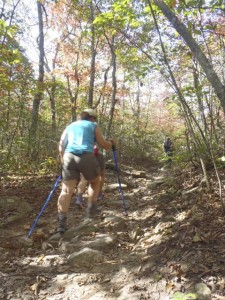
My favorite correspondent reported in from Colorado that she’d been hiking an area known as the hogback, a geologic formation that constitutes a precursor to the foothills of the Front Range. Having once lived near the hogback, she knew that in itself would interest me. Then she sweetened the pot.
“A lot of the hikers were using hiking poles,” she said. And no, she confirmed, they weren’t all older hikers. “It was a mix.”
It struck us both ironic that in the fitest state in the nation hikers are quick to use the aid, while here in one of the least fit states we continue to wobble along poleless. One thing those Coloradans may know that we don’t: using poles makes for a better workout.
“Walking poles work your arms, shoulders, chest and upper back muscles through a functional range of motion as you walk — which can help you turn your daily walk into a full-body workout,” according to Dr. Edward R. Laskowski with the Mayo Clinic. “The arm movement associated with walking poles adds intensity to your aerobic workout, which helps you burn more calories.”
I lead a couple of hiking groups, including GetHiking! Triangle. Courtesy of Great Outdoor Provision Co., I keep six loaner hiking poles in my car trunk. Before every hike I announce their availability. On a recent outing with 43 hikers, four took me up on the offer, with two making comments to the effect of, “Guess this makes me old now.”
No, using doesn’t make you old. In fact, it keeps you from getting old, at least parts of you. Other advantages to poles, according to Dr. Laskowski:
- Walking poles improve balance and stability.
- Walking poles help you maintain proper posture, especially in the upper back, and may help to strengthen upper back muscles.
- Walking poles take some of the load off your lower back, hips and knees, which may be helpful if you have arthritis or back problems.
Balance and stability: This is an especially big plus on our trails, most of which are peppered with rocks and tree roots, and where the occasional stream crossing, over slippery and unstable rocks, is required.
Maintain proper posture: Ever get to the end of a six-mile hike and realize you look (and feel) like Quasimodo? Poles help keep you upright and minimize unhealthy strain.
Take a load off: Stop me if you’ve heard this story before — because I know I’ve told it a couple hundred times — but when I was reporting “Backpacking North Carolina” a few years ago, I’d return from a week in the field with my knees puffed up like beach balls. Three days would pass before the swelling subsided and I didn’t walk like Walter Brennan. I relented, bought a pair of trekking poles and haven’t had trouble since.
There are other practical uses for hiking poles — 25 are enumerated at TheNatureofHiking.com — making the resistance to them even more baffling.
Hiking poles aren’t expensive — the Black Diamond loaners in my trunk range from $79.99 to $149.99 — and they’re convenient, breaking down for easy storage.
If you’re tired of your knees, your back, your hips being tired, come on a hike with us and I’ll loan you some poles. Two minutes of instruction and you’ll be on your way to healthier, happier hiking.
Just like they do in Colorado.
* * *
Check out our GetHiking! Triangle hiking group here. Find a hike and come borrow some poles.